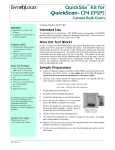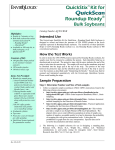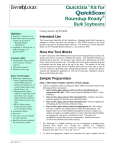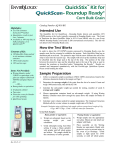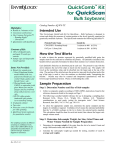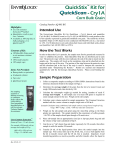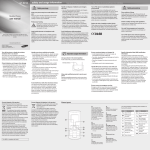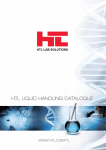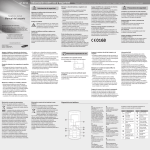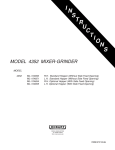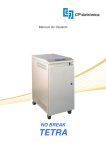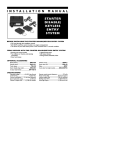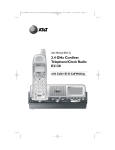Download Product Insert: AH / AHS
Transcript
QuickStix™ Kit for - CP4 EPSPS Ground Alfalfa Hay Catalog Number AQ 045 AH Contents of Kit: 50 QuickStix Strips packed in a moisture-resistant canister 20X EB2 Extraction Buffer Concentrate* reaction vials transfer pipettes *1X Extraction Buffer must be prepared from 20X Concentrate Items Not Provided: Oster blender or equivalent for grinding hay Portable scale to weigh ground hay (ProScale CP120 or equivalent) 40-mesh sieve (optional) Graduated cylinder† Sample extraction vessels (eg, disposable sample cups with lids)† † Available through EnviroLogix as Accessories, see page 3 Part # 11968 Intended Use This EnviroLogix QuickScan Kit for CP4 EPSPS Ground Alfalfa Hay detects and quantifies CP4 EPSPS protein in ground alfalfa hay at 0.1%, dependent upon the expression level of the Roundup Ready plant. This test is intended to give the producer, purchaser, or exporter a screening method for identification of the presence of Roundup Ready alfalfa hay from ground hay samples at levels of 0.1%, based on weight/weight (w/w) ratios. The results of each sample tested are only as representative as the sample is of the entire lot, so adherence to proper principles of hay sampling is key; see "Important-Representative Sample" below. How the Test Works In order to test for the CP4 EPSPS protein expressed by Roundup Ready alfalfa hay, an extract of the composite hay sample must be prepared. Extracts of cored hay and ground hay are prepared for testing using different methods (see Sample Preparation section). Each QuickStix Strip has an absorbent pad at each end. The protective tape with arrows indicates the end of the strip to insert into the sample extract. The sample travels up the membrane strip and is absorbed into the larger pad at the top of the strip. The portion of the strip between the protective tape and the absorbent pad at the top of the strip is used to view the reactions as described under “Interpreting the Results.” Results are scanned and interpreted quantitatively with the EnviroLogix QuickScan System. Please avoid bending the strips. Sample Preparation Prepare 1X Extraction Buffer: Mix 50 mL of 20X Concentrate with 950 mL of distilled or deionized water. Store refrigerated when not in use; allow to come to room temperature before using. Important-Representative Sample: It is very important that the sample tested is representative of the entire lot of hay. A composite sample for each hay lot is required to run the test. A helpful reference is "Recommended Principles for Proper Hay Sampling" by Dan Putnam, University of California, Davis. Once a representative sample has been obtained, grind hay using an Oster blender or equivalent to a consistency that will allow ground materials to pass through a 40-mesh sieve, see illustration below showing grind quality. Use Oster Blender or equivalent 40 mesh sieve size equates to particles that are 420 microns (0.42mm) in size Rev. 11-13-14 Unground sample Ground for 1 minute, contains plenty of 40-mesh particles—test the finest particles possible Example of a sample sifted through 40-mesh sieve QuickScan Kit for Roundup Ready Alfalfa Hay Page 2 of 4 Important-Clean Between Samples: All grinding and weighing equipment, as well as testing surfaces, must be cleaned thoroughly if a sample tests positive to ensure there is no crosscontamination to the next sample. It is advisable that disposable pipettes and vials be stored closed and only removed when used to prevent the potential for dust affecting the performance of the test on subsequent samples. If possible, use separate rooms for grinding/weighing and testing. 1. After grinding composite sample, remove 1 gram and place in the extraction vessel. Use a balance to weigh out ground material carefully and avoid crosscontaminating samples with hay fines. Measure carefully and add 80mL of prepared 1X Extraction Buffer to the disposable sample cup containing hay and securely close the lid. 2. Shake cup for 1 minute by hand. Look at the bottom of the cup and confirm that all material is wet from the shaking process before proceeding. Continue shaking until all material is wet. 3. Draw up enough liquid portion from the settled sample to fill the long narrow tip of the transfer pipette up to the line at the top of the flared portion of the pipette bulb (see illustration, left). Avoid pulling up particles. Dispense extract (~0.5 mL) into reaction vial. Carefully weigh out sample and measure 1X Extraction Buffer Shake well – the sample may tend to clump together and/or adhere to the cup, so check carefully and make sure all dry material is wet Tip sample cup if needed to avoid particulates when pipetting How to Run the QuickStix Strip Test 1. Allow refrigerated canisters to come to room temperature before opening. Remove the QuickStix Strips to be used. Avoid bending the strips. Reseal the canister immediately. 2. Place one strip, colored arrows pointing down, into the reaction vial containing extract. The sample will travel up the strip. 3. Allow the strip to develop for 5 minutes before making final assay interpretations. 4. Immediately cut off and discard the bottom section of the strip covered by the arrow tape and place in the QuickScan Reader. Strips must be read while still wet. Alternatively, strips may be read visually at this point. Do not save strips. NOTE: Use extreme caution to prevent sample-to-sample cross-contamination with hay, dust, fluids, or disposables. Interpreting the Results 0.5 mL Transfer 0.5 mL to reaction vial Development of the Control Line within 5 minutes indicates that the strip has functioned properly. Any strip that does not develop a Control Line should be discarded, and the sample re-tested using another strip. Results are scanned and interpreted quantitatively with the QuickScan System. Place QuickStix into the carrier, slide in, and press “Read Test” on the screen. QuickScan will return a result as “% GMO” or “<LOD” (less than the Limit of Detection). Please consult the QuickScan User Manual for details. The test may be used qualitatively without the use of QuickScan. A visible pink test line will appear if the sample contains 0.1% CP4 EPSPS or more. If the extract is from a sample with less than 0.1% CP4 EPSPS, the strip will only develop the Control Line. Rev. 11-13-14 QuickScan Kit for Roundup Ready Alfalfa Hay Page 3 of 4 Top pad Kit Storage This kit can be stored at room temperature, or refrigerated for a longer shelf life. Please note the shelf life on the kit label for each storage temperature. The kit may be used in field applications; however, prolonged exposure to high temperatures may adversely affect the test results. Do not open the desiccated canister until ready to use the test strips. Precautions and Notes • • • This end in sample • • • • • • • This kit is designed to give quantitative results using the QuickScan System and may also be visually interpreted. The strips will detect Roundup Ready protein in sample extracts prepared following the specified extraction procedure at composite hay levels of approximately 0.1% (w/w) Roundup Ready alfalfa or more, and is dependent upon the expression level of the Roundup Ready alfalfa plant. An example of a 0.1% (w/w) sample would be a mixed composite sample containing 0.1 grams of Roundup Ready alfalfa hay and 99.9 grams of conventional alfalfa hay. This product is currently not applicable for use in any other crop. As with all tests, it is recommended that results be confirmed by an alternate method when necessary. The assay has been optimized with the protocol and with the buffer provided in the kit. Deviation from this protocol may invalidate the results of the test. The results generated through the proper use of this diagnostic tool reflect the condition of the working sample directly tested. Extrapolation as to the condition of the originating lot, from which the working sample was derived, should be based on sound sampling procedures and statistical calculations which address random sampling effects, non-random seed lot sampling effects and assay system uncertainty. A negative result obtained when properly testing the working sample does not necessarily mean the originating lot is entirely negative for the analyte or protein in question. A negative result with this kit does not mean that the sampled tissue has not been otherwise genetically modified. It is not safe to conclude that a sample is negative before a full 5 minutes have elapsed. Protect all components from hot or cold extremes of temperature when not in use. Do not leave in direct sunlight or in vehicle. Accessories available through EnviroLogix Rev. 11-13-14 Sample cups with lids (50) Sample cups with lids (500/case) ACC 012-CS 10167 Graduated cylinder (100 mL) 11207 ACC 012 ACC 068 11224 QuickScan Kit for Roundup Ready Alfalfa Hay Page 4 of 4 LIMITED WARRANTY EnviroLogix Inc. (“EnviroLogix”) warrants the products sold hereunder (“the Products”) against defects in materials and workmanship when used in accordance with the applicable instructions for a period not to extend beyond a product’s printed expiration date. If the Products do not conform to this Limited Warranty and the customer notifies EnviroLogix in writing of such defects during the warranty period, including an offer by the customer to return the Products to EnviroLogix for evaluation, EnviroLogix will repair or replace, at its option, any product or part thereof that proves defective in materials or workmanship within the warranty period. For Technical Support Contact Us At: EnviroLogix 500 Riverside Industrial Parkway Portland, ME 04103-1486 USA Tel: (207) 797-0300 Toll Free: 866-408-4597 Fax: (207) 797-7533 e-mail: [email protected] website: www.envirologix.com NEITHER ENVIROLOGIX NOR MONSANTO MAKES ANY OTHER WARRANTIES, EXPRESS OR IMPLIED, INCLUDING BUT NOT LIMITED TO ANY IMPLIED WARRANTIES OF MERCHANTABILITY OR FITNESS FOR A PARTICULAR PURPOSE. The warranty provided herein and the data, specifications and descriptions of EnviroLogix products appearing in EnviroLogix published catalogues and product literature are EnviroLogix’ sole representations concerning the Products and warranty. No other statements or representations, written or oral, by EnviroLogix’ employees, agents or representatives, except written statements signed by a duly authorized officer of EnviroLogix Inc., are authorized; they should not be relied upon by the customer and are not a part of the contract of sale or of this warranty. EnviroLogix does not warrant against damages or defects arising in shipping or handling, or out of accident or improper or abnormal use of the Products; against defects in products or components not manufactured by EnviroLogix, or against damages resulting from such nonEnviroLogix made products or components. EnviroLogix passes on to customer the warranty it received (if any) from the maker thereof of such non-EnviroLogix made products or components. This warranty also does not apply to Products to which changes or modifications have been made or attempted by persons other than pursuant to written authorization by EnviroLogix. THIS WARRANTY IS EXCLUSIVE. The sole and exclusive obligation of EnviroLogix shall be to repair or replace the defective Products in the manner and for the period provided above. EnviroLogix shall not have any other obligation with respect to the Products or any part thereof, whether based on contract, tort, strict liability or otherwise. Under no circumstances, whether based on this Limited Warranty or otherwise, shall EnviroLogix be liable for incidental, special, or consequential damages. This Limited Warranty states the entire obligation of EnviroLogix with respect to the Products. If any part of this Limited Warranty is determined to be void or illegal, the remainder shall remain in full force and effect. License EnviroLogix has developed this kit using proprietary reagents as well as reagents licensed from Monsanto Company. Roundup Ready is a registered trademark of Monsanto Technology, LLC EnviroLogix, the EnviroLogix logo, and QuickStix are trademarks of EnviroLogix Inc. © EnviroLogix 2014 Rev. 11-13-14




